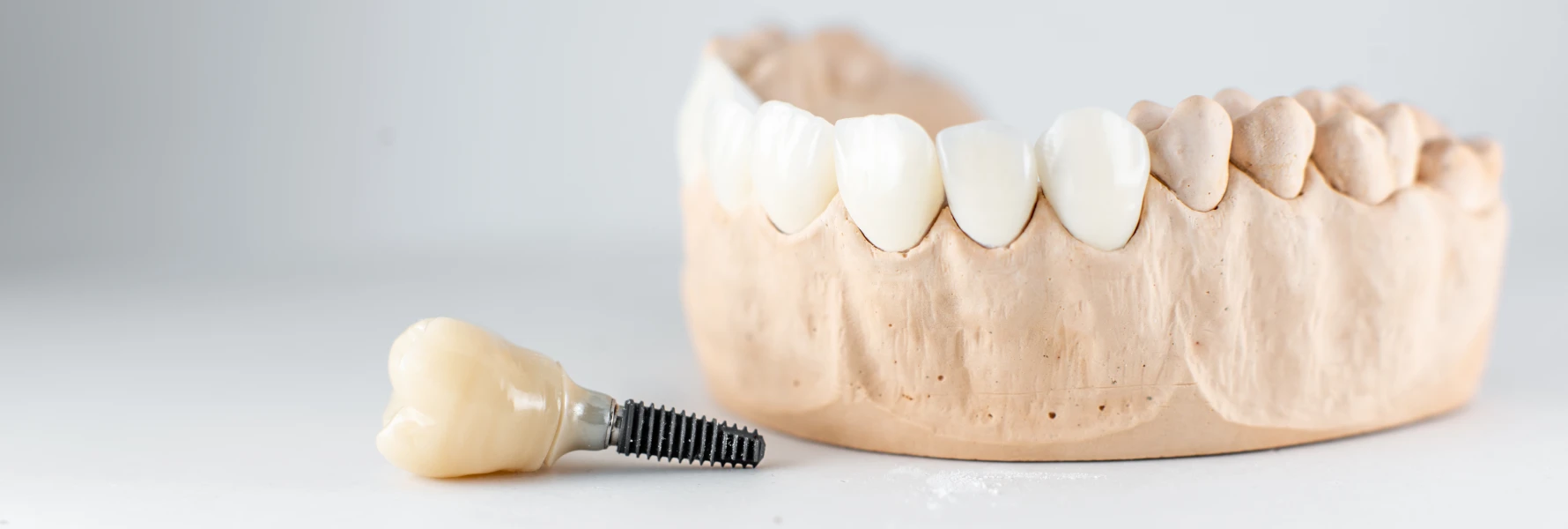Dental implant placement involves inserting a medical device into the jawbone to replace the root of a missing tooth. Usually made of titanium, a biocompatible material, or ceramic, the implant serves as a support for a crown, bridge, or removable denture. The goal is to restore chewing function, maintain the alignment of adjacent teeth, and preserve bone volume, which naturally tends to decrease when a tooth has been missing for a long time.

The implant functions as an artificial root and gradually fuses with the bone through a process called osseointegration. This treatment is suitable both for patients missing a single tooth and for those missing several teeth. In some cases, implants can also support complete dentures.
Before considering dental implant placement, the dentist conducts a thorough examination of the mouth and evaluates the patient’s general health. This assessment determines treatment feasibility, anticipates the different steps, and ensures all conditions are met for a long-lasting result.
Why consider this treatment
This type of tooth replacement offers numerous benefits — functional, aesthetic, and preventive. Unlike certain fixed solutions, it does not require altering adjacent teeth. The implant acts as an artificial root, stimulating the jawbone and helping to prevent progressive bone loss. This preserves the facial structure and contributes to daily comfort.
In addition to restoring proper chewing, an implant helps maintain natural jaw movement, which facilitates speech and swallowing. Aesthetically, it blends harmoniously with surrounding teeth, maintaining a natural smile and balanced facial expression.

Key benefits to remember:
- Replacement of a missing tooth without altering neighboring teeth
- Preservation of bone volume through jaw stimulation
- Improved chewing and comfort during meals
- Maintenance of natural articulation for clear speech
- Aesthetic integration and support for facial structure
These factors show that implant treatment is not only cosmetic — it also plays a vital role in overall oral health. It restores efficient chewing, prevents bone loss, and helps maintain long-term balance within the mouth. For this reason, the dentist places great importance on the initial evaluation to ensure optimal conditions for lasting success and stability.
Stages of dental implant placement
Implant placement is not a single procedure. It follows a structured, multi-step protocol to guarantee optimal integration and long-term function. The total duration may vary depending on the complexity of the case, bone quality, and whether preparatory procedures are required.
The process always begins with an information session. This allows the dentist to clearly explain the treatment plan, steps, and possible alternatives. The patient can ask questions and fully understand the process. A projected timeline is often provided to help organize appointments.
Initial evaluation and planning
This first step is essential. The dentist performs a complete clinical examination, assessing the condition of the teeth, gums, and jawbone.
Imaging tests — such as panoramic X-rays or 3D scans — provide a detailed view of bone structure and help identify the position of nerves and sinuses.
Bone density and volume are determining factors. If bone volume is insufficient, a bone graft or sinus lift may be recommended before implant placement. The dentist also reviews medical history and ongoing treatments. Certain factors such as smoking or chronic conditions may affect healing and require additional precautions.

Surgical procedure
Implant placement is performed under local anesthesia, sometimes combined with conscious sedation for maximum comfort. After disinfecting the area, the dentist makes a small incision in the gum to access the bone, inserts the implant with specialized instruments, and places a healing cap to protect the site.
The procedure typically lasts 30 minutes to just over an hour, depending on the number of implants placed. After surgery, the patient should rest and follow a soft diet to avoid stressing the area. The dentist provides detailed instructions to maintain optimal hygiene during recovery.
Healing phase
Osseointegration is a key stage — it refers to the gradual fusion between the implant and bone, ensuring stability. This phase can take 6 to 12 weeks, sometimes longer if bone quality was initially low or a graft was performed. Regular follow-ups help monitor healing, detect any inflammation, and guide proper maintenance.
Prosthesis placement
Once integration is confirmed, the dentist takes an impression to design the custom-made prosthesis. The restoration is fabricated to match the shape, size, and color of the natural teeth. It is then secured on an abutment attached to the implant and adjusted to ensure comfort and effective chewing.
Replacing a missing tooth with a dental implant means regaining comfort, stability, and confidence in your smile.
Follow-up and maintenance

The longevity of a dental implant depends directly on proper care. Daily brushing, the use of interdental brushes, and regular dental visits are essential. Professional cleanings help remove plaque and tartar around the implant, reducing the risk of inflammation such as mucositis or peri-implantitis.
It is also recommended to avoid habits like teeth grinding or chewing excessively hard foods that could damage the prosthesis. Regular follow-up appointments are key to ensuring the long-term success of the treatment.
FAQ – Dental implants
- Is dental implant placement painful?
No. Local anesthesia makes the procedure painless. After surgery, some discomfort or swelling may occur, but it is usually well managed with simple care. - How long does a dental implant last?
With proper maintenance, an implant can remain functional for several decades. - Can an implant be placed immediately after extraction?
Yes, if bone and gum conditions are favorable. This approach can sometimes avoid a second surgery. - Is there a minimum or maximum age?
Implant placement is possible once bone growth is complete — usually at the end of adolescence. There is no strict upper age limit as long as overall health allows. - Is the implant visible?
No. The implant is placed within the bone and covered by the gum. Only the attached prosthesis is visible — designed to blend seamlessly with natural teeth.
Book an appointment
To receive personalized information or schedule a consultation for dental implant placement, you can contact the Cabinet dentaire Mirabeau in Paris 16. Online booking is available to arrange a complete assessment and determine the solution best suited to your needs.
You may also like: Bone grafting